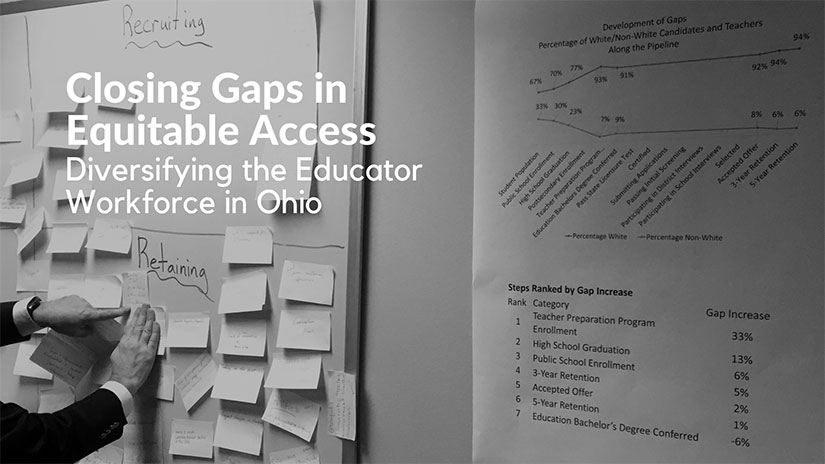Equitable Access & Diversifying the Educator Workforce
An effective workforce is a diverse workforce: outcomes for all students improve when teachers reflect the diversity of the student body. Because diversifying the educator workforce is a necessary condition for closing gaps in equitable access, the GTL Center's work includes a particular focus on this issue for 2018-2019. Closing gaps in access to effective educators can be done, but it requires:
- robust and systematic state and local policies and
- evidence-based strategies selected specifically to meet the needs of each state, district, and school context.
The GTL Center offers a suite of resources to support Equitable Access Planning and Implementation as well as in-depth technical assistance to states and districts. Explore below to see descriptions of our work with states and districts this year, as well as new tools and resources just recently released.
Year 7 Projects

Ohio: Diverse Educators for Rural, Low-Income, and Hard-to-Staff Positions
The GTL Center and the Great Lakes Comprehensive Center are helping the Ohio Department of Education (ODE) to write a state plan with strategies for diversifying the educator workforce. ODE is using the GTL Center's Data Tool (see below) to gather and analyze workforce data, complete a root cause analysis, and engage in action planning to identify and select strategies as part of their statewide plan.

Connecticut: Improving Hiring Practices to Strengthen Workforce Diversity
The GTL Center and the Northeast Comprehensive Center are supporting the Connecticut State Department of Education (CSDE) in its efforts to help districts to diversify their educator workforce through better hiring practices. Center supports include training, hiring tools, self-assessments and action planning. State agency staff are using these tools and resources to create parallel supports for districts engaged in this work.

Mississippi and the Diverse and Learner Ready Teacher Initiative (DLRT)
The GTL Center is supporting Mississippi Department of Education (MDE) as an expert facilitator in the Council of Chief State School Officers’ Diverse and Learner Ready Initiative (DLRT). MDE is working to develop a statewide plan using evidence-based strategies for diversifying the state's educator workforce.
Project Highlight
The Ohio Department of Education is working with a group of 40 stakeholders as well as the GTL Center and the Great Lakes Comprehensive Center to develop concrete strategies for diversifying the state's educator workforce. Using the GTL Center's Diversifying the Educator Workforce Data Tool, the group is completing a four-step process that starts with first examining the state's educator workforce data to identify diversity gaps and exploring the root causes behind those gaps. Learn more about this important work in our lastest project highlight.
Key Equitable Access Resources
Decision Points: Defining, Calculating, and Addressing Gaps in Access to Effective Educators (Special Issues Brief, May 2019)
ESSA requires states to identify and close gaps in equitable access to effective teachers, but states have flexibility on how to get there. This brief offers four decision points states can consider in developing and implementing policy on this topic. State education agencies can use this brief to:
- Define terms and parameters for equitable access reporting.
- Explore examples of state-level initial equity planning and results reporting.
- Consider ways to support districts by looking at detailed examples of ways states are supporting districts to address identified equity gaps.
Insights on Diversifying the Educator Workforce: A Data Tool for Practitioners is our free, Excel-based, user-friendly tool helps states, educator preparation programs, regional education agencies, and districts to identify and visualize diversity gaps across the entire educator career continuum, from “future teachers” graduating from high school and entering preparation programs, to preservice teachers entering the educator workforce, and growing and developing into experienced classroom instructors.
After states and districts have examined their workforce data, engaged stakeholders, and conducted a root cause analysis, the next step is to use the information gathered through these processes to inform strategy selection. Evidence-Based Strategy Toolkits: For State and District Equitable Access Planning can help states and districts both during the data analysis and strategy selection steps, particularly to identify customized, evidence-based strategies that meet unique local needs. The toolkits currently available include teacher leadership, mentoring and induction, diversifying the teacher workforce, and addressing educator shortages in special education (forthcoming July 2019).
Changing inequities in access to excellent educators requires states, districts, and educator preparation providers to collaborate in a thoughtful, rigorous planning and implementation process. The GTL Center provides a comprehensive suite of tools and resources to guide states and their stakeholders through each step in a customized process grounded in implementation science. Explore the process, tools, and resources on our Equitable Access Supports page.
In The News
By Roxanne Garza
June 25, 2019
In the second post in a new series, Etai Mizrav, senior technical assistance consultant and equity content leader at the GTL Center explains how diversifying the teacher workforce will improve teacher quality, and specifically how the GTL Center is working with practitioners to help identify root causes for disparities within the teacher workforce.
Contact
Senior Technical Assistance Consultant
Center on Great Teachers and Leaders






